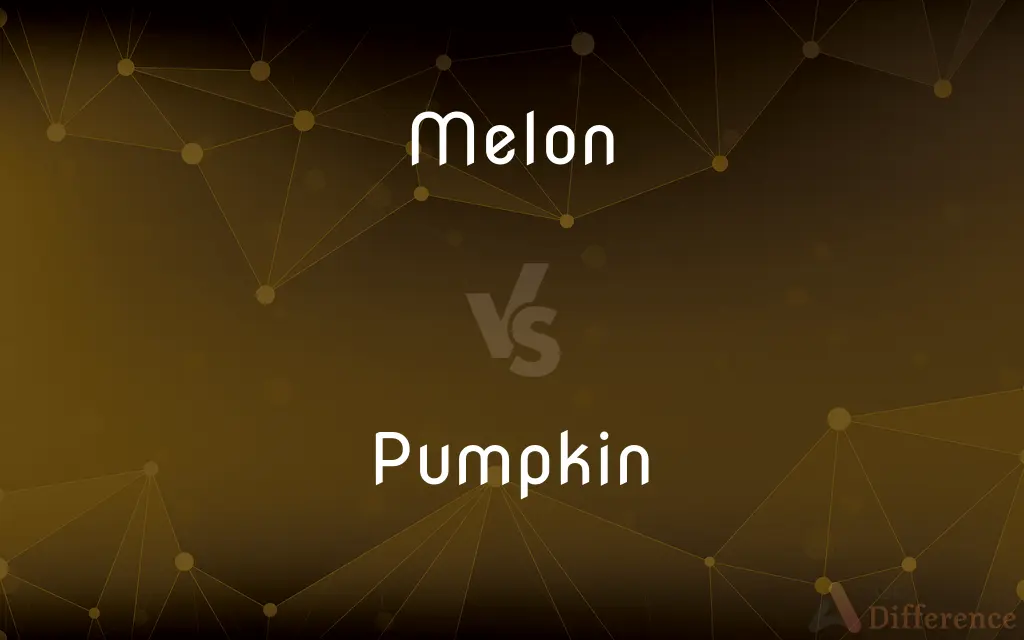Melon vs. Pumpkin — What's the Difference?
By Urooj Arif & Fiza Rafique — Updated on April 24, 2024
Melons are typically sweet, water-rich fruits used in desserts and salads, while pumpkins are starchy squashes often used in savory dishes and pies.

Difference Between Melon and Pumpkin
Table of Contents
ADVERTISEMENT
Key Differences
Melons, such as cantaloupe and watermelon, are part of the Cucurbitaceae family and are primarily grown for their sweet, hydrating flesh. On the other hand, pumpkins are also members of the Cucurbitaceae family but are cultivated for their dense, mildly sweet flesh which is versatile in both savory and sweet culinary uses.
The typical melon has a smooth or netted skin and comes in various sizes, depending on the variety. Whereas pumpkins are recognized by their thick, often ribbed skin that ranges in color from deep orange to pale green.
Melons are generally consumed raw, often in fruit salads or as a refreshing snack. In contrast, pumpkins are commonly cooked and used in preparations like soups, pies, and roasts.
The growing season for melons usually peaks in summer, making them a seasonal favorite during hot weather. Conversely, pumpkins are harvested in the fall, aligning them with autumn festivities, particularly Halloween and Thanksgiving.
Nutritionally, melons are high in water content and vitamins A and C, making them excellent for hydration and antioxidant intake. Pumpkins, however, are rich in vitamins A and E, fiber, and potassium, offering different health benefits.
ADVERTISEMENT
Comparison Chart
Family
Cucurbitaceae
Cucurbitaceae
Skin Texture
Smooth or netted
Thick, often ribbed
Typical Use
Eaten raw in salads, desserts
Cooked in pies, soups, roasts
Harvest Season
Summer
Fall
Nutritional Highs
High in water, vitamins A and C
Rich in vitamins A, E, fiber, potassium
Compare with Definitions
Melon
A sweet, fleshy fruit that grows on vines and is typically eaten fresh.
She sliced the melon for the picnic.
Pumpkin
A large, round, orange squash with a thick rind, typically carved for Halloween.
We carved faces into pumpkins for Halloween.
Melon
A plant that produces these fruits, often trailing on the ground.
They grew melons in their backyard garden.
Pumpkin
The plant that produces these large squashes, characterized by sprawling vines.
Her garden’s pumpkin vines spread across the yard.
Melon
Informal use can refer to large amounts or abundance.
He made a melon of money in the stock market.
Pumpkin
Used metaphorically to denote something big and impressive.
His new project is a real pumpkin.
Melon
A term used to describe something round and large.
The setting sun was a big orange melon.
Pumpkin
A term used affectionately, often for children or loved ones.
Come here, my little pumpkin!
Melon
Any of various fruits of the Cucurbitaceae family with a hard rind.
Melons vary widely in size and color.
Pumpkin
Culturally, associated with fall and festive traditions.
They baked pumpkin pies for the autumn festival.
Melon
A melon is any of various plants of the family Cucurbitaceae with sweet, edible, and fleshy fruit. The word "melon" can refer to either the plant or specifically to the fruit.
Pumpkin
A pumpkin is a cultivar of winter squash that is round with smooth, slightly ribbed skin, and is most often deep yellow to orange in coloration. The thick shell contains the seeds and pulp.
Melon
The large round fruit of a plant of the gourd family, with sweet pulpy flesh and many seeds
A slice of melon
A ripe melon will smell sweet
Pumpkin
A round, often large squash with coarse, strongly flavored yellow to orange flesh, numerous seeds, and a moderately hard, usually orange rind.
Melon
The Old World plant which yields the melon.
Pumpkin
Any of several plants producing these fruits, especially varieties of the species Cucurbita pepo, and also varieties of C. maxima and C. moschata.
Melon
A waxy mass in the head of dolphins and other toothed whales, thought to focus acoustic signals.
Pumpkin
A moderate to strong orange.
Melon
Any of various vines of the family Cucurbitaceae, especially Cucumis melo or Citrullus lanatus, widely cultivated for their edible fruit.
Pumpkin
A domesticated plant, in species Cucurbita pepo, similar in growth pattern, foliage, flower, and fruit to the squash or melon.
Melon
The fruit of any of these plants, having a hard rind and juicy flesh.
Pumpkin
The round yellow or orange fruit of this plant.
Melon
A fatty structure in the forehead of cetaceans, especially the toothed whales, thought to be used in the production of high-frequency sounds.
Pumpkin
(uncountable) The color of the fruit of the pumpkin plant.
Melon
(countable) Any of various plants of the family Cucurbitaceae grown for food, generally not including the cucumber.
Pumpkin
(Australia) Any of a number of cultivars from the genus Cucurbita; known in the US as winter squash.
Melon
Genus Cucumis, various musk melons, including honeydew, cantaloupes, and horned melon.
Pumpkin
(US) A term of endearment for someone small and cute.
Melon
Genus Citrullus, watermelons and others
Pumpkin
A well-known trailing plant (Cucurbita pepo) and its fruit, - used for cooking and for feeding stock; a pompion.
Melon
Genus Benincasa, a winter melon
Pumpkin
A coarse vine widely cultivated for its non-keeping large pulpy round orange fruit with firm orange skin and numerous seeds; subspecies of Cucurbita pepo include the summer squashes and a few autumn squashes
Melon
Genus Momordica, a bitter melon
Pumpkin
Usually large pulpy deep-yellow round fruit of the squash family maturing in late summer or early autumn
Melon
(uncountable) Fruit of such plants.
Melon
(uncountable) A light pinkish orange colour, like that of some melon flesh.
Melon
The head.
Think! Use your melon!
Melon
A member of the Green Party, or similar environmental group.
Melon
(countable) A mass of adipose tissue found in the forehead of all toothed whales, used to focus and modulate vocalizations.
Melon
(chemistry) The result of heptazine being polymerized with the tri-s-triazine units linked through an amine (NH) link.
Melon
Of a light pinkish orange colour, like that of melon flesh.
Melon
The juicy fruit of certain cucurbitaceous plants, as the muskmelon, watermelon, and citron melon; also, the plant that produces the fruit.
Melon
A large, ornamental, marine, univalve shell of the genus Melo.
Melon
Any of numerous fruits of the gourd family having a hard rind and sweet juicy flesh
Melon
Any of various fruit of cucurbitaceous vines including: muskmelons; watermelons; cantaloupes; cucumbers
Common Curiosities
What is the best climate for growing pumpkins?
Pumpkins grow best in a temperate climate with warm soil.
What are the main types of melons?
Common types include cantaloupe, honeydew, and watermelon.
How do pumpkins contribute to health?
Pumpkins are high in vitamins, fiber, and antioxidants.
Can you eat melon seeds?
Yes, melon seeds are edible and often roasted for a snack.
Are melons low in calories?
Yes, melons are low in calories due to their high water content.
What dishes use melons?
Melons are used in fruit salads, smoothies, and desserts.
What are the traditional uses of pumpkins?
Traditionally used in pies, carving, and as fall decor.
Is pumpkin a fruit or a vegetable?
Botanically, pumpkin is a fruit because it contains seeds.
Can pumpkins be eaten raw?
While edible, pumpkins are usually cooked to improve texture and flavor.
How do you store melons to keep them fresh?
Keep uncut melons at room temperature and refrigerate when cut.
How long does it take for a pumpkin to mature?
It typically takes about 90 to 120 days for a pumpkin to mature.
How do pumpkins affect baking?
Pumpkin puree adds moisture and flavor to baked goods.
What are the seed benefits of melons?
Melon seeds are rich in proteins, vitamins, and minerals.
Which has more sugar, melon or pumpkin?
Melons generally contain more sugar than pumpkins.
What is the difference in water content between melons and pumpkins?
Melons have a higher water content compared to pumpkins.
Share Your Discovery

Previous Comparison
Durian vs. Jackfruit
Next Comparison
Motif vs. PatternAuthor Spotlight
Written by
Urooj ArifUrooj is a skilled content writer at Ask Difference, known for her exceptional ability to simplify complex topics into engaging and informative content. With a passion for research and a flair for clear, concise writing, she consistently delivers articles that resonate with our diverse audience.
Co-written by
Fiza RafiqueFiza Rafique is a skilled content writer at AskDifference.com, where she meticulously refines and enhances written pieces. Drawing from her vast editorial expertise, Fiza ensures clarity, accuracy, and precision in every article. Passionate about language, she continually seeks to elevate the quality of content for readers worldwide.














































